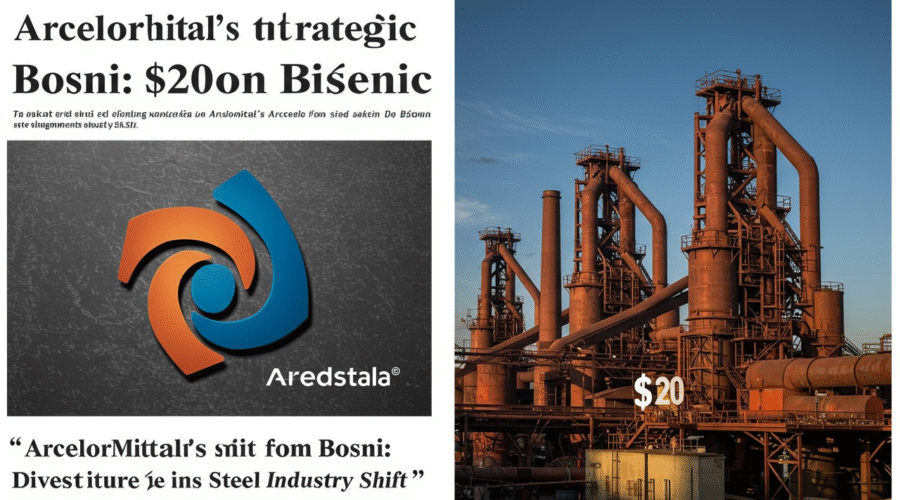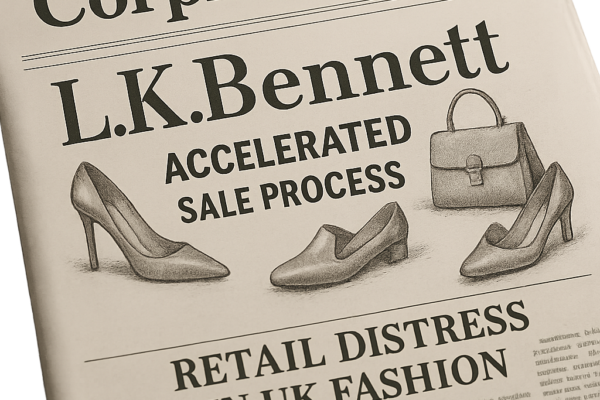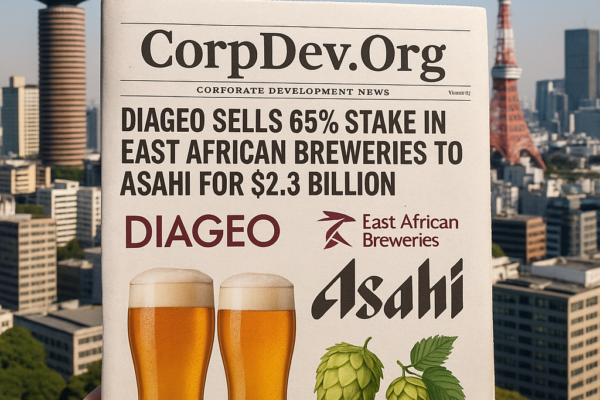ArcelorMittal’s sale of its Bosnian operations to Pavgord Group represents a significant strategic pivot in the global steel industry, with the Luxembourg-based steelmaker divesting its Zenica steel mill and Prijedor iron ore mine after 21 years of operation. The transaction, signed on June 20, 2025, includes the transfer of all 2,700 employees to the Bosnia-based industrial group and is expected to close in Q3 2025 following regulatory approvals. ArcelorMittal anticipates recording a $200 million non-cash loss from the disposal, concluding a period of sustained losses totaling $325 million over 2023-2024 due to declining European steel demand. This divestiture exemplifies broader industry trends where multinational steel producers are rationalizing portfolios toward high-margin, low-carbon assets while regional players consolidate industrial footprints[1][2][3][9][10][11][12].
💼 Seasoned CorpDev / M&A / PE expertise
The Bosnia Divestiture: Transaction Architecture and Operational Context
Asset Portfolio and Transaction Mechanics
The divested assets constitute an integrated production ecosystem: the Zenica steel mill features 950,000-ton annual capacity with coke plant, blast furnace, steelmaking, and rolling mill operations, while the Prijedor mine supplies iron ore concentrate through gravity-magnetic separation technology producing 1.5 million tons annually. The vertically integrated structure historically enabled raw material security but couldn’t overcome systemic challenges including aging infrastructure and energy inefficiencies. Under the sale and purchase agreement, Pavgord Group assumes all outstanding liabilities and debt obligations alongside acquiring 100% equity in both entities. Crucially, the transaction includes continuity covenants ensuring employee retention under existing collective agreements, mitigating social disruption risks in Bosnia’s industrial heartland[1][3][11][14][15].
Financial Implications and Historical Performance
ArcelorMittal’s $200 million non-cash impairment charge reflects accumulated operational losses and currency translation adjustments since acquisition, with the Bosnia division reporting consecutive annual losses of $162.6 million in both 2023 and 2024. This financial underperformance stemmed primarily from compressed margins amid Europe’s steel demand contraction, where apparent consumption fell 6.3% in 2023 with only a constrained 5.6% rebound projected for 2024. The Zenica facility operated at just 45% capacity utilization in 2024, unable to offset fixed costs despite being Bosnia’s largest steel exporter and contributing 2.5% to national GDP. This divestiture follows ArcelorMittal’s established pattern of non-core asset exits, including the 2020 sale of its U.S. operations to Cleveland-Cliffs for $1.4 billion in cash and stock[1][3][7][11][16].
Strategic Drivers: Portfolio Rationalization in a Transforming Industry
ArcelorMittal’s Capital Reallocation Framework
The Bosnia exit exemplifies CEO Aditya Mittal’s “selective growth” strategy prioritizing capital deployment toward decarbonization technologies and high-margin markets. This transaction frees approximately $150 million in annual capital expenditure previously allocated to maintenance of aging Bosnian assets, resources now redirectable toward electric arc furnace (EAF) projects like the 1.5 million-ton facility under construction in Calvert, Alabama. The company’s strategic calculus weighs regional exposure against energy transition imperatives, with European operations requiring disproportionate investment to meet EU Carbon Border Adjustment Mechanism compliance. This divestiture follows ArcelorMittal’s 2022 acquisition of voestalpine’s Texas HBI plant, demonstrating a systematic shift toward lower-carbon metallics production for premium markets[3][8][12][13].
European Steel’s Structural Challenges
ArcelorMittal’s retreat from Bosnia underscores sector-wide pressures where energy costs constitute 40% of production expenses versus 20% globally, compounded by EU emissions trading scheme compliance costs adding €100/ton to production. The European Steel Association (EUROFER) documents six consecutive quarters of consumption decline through Q3 2023, with 2024 demand recovery constrained by persistent inflation and monetary tightening. These conditions accelerated portfolio rationalization across European producers, including Tata Steel’s planned closure of Port Talbot blast furnaces and Thyssenkrupp’s sale of steel division to Czech billionaire Daniel Křetínský. The Bosnia sale represents ArcelorMittal’s third European divestiture in 18 months, following Kazakhstan operations and Italian specialty steel unit sales[12][13][16].
Pavgord Group: Regional Consolidation and Integration Synergies
Acquirer Profile and Industrial Footprint
Pavgord Group enters as a formidable regional industrial conglomerate with existing dominance in Bosnia’s non-ferrous sector through ownership of Alumina d.o.o. (the country’s largest exporter in 2024) and majority control of bauxite miner Boksit. The Zenica-Prijedor acquisition marks Pavgord’s strategic diversification into ferrous metals, creating potential for cross-sector operational synergies. The group’s existing transportation infrastructure and energy procurement frameworks may lower operating costs by 15-20% versus multinational ownership, while its established government relationships facilitate smoother regulatory navigation. However, modernization requirements present significant challenges, with industry analysts estimating $300-400 million needed for environmental compliance upgrades and energy efficiency retrofits at the 133-year-old Zenica facility[1][4][6][13].
Vertical Integration Opportunities
The transaction creates immediate upstream-downstream integration potential, with Prijedor’s iron ore output potentially supplying Pavgord’s existing metallurgical operations beyond steel production. Technical specifications indicate Prijedor’s lump ore concentrate (54% Fe) could substitute imported raw materials at Alumina’s aluminum smelters, while bauxite byproducts from Boksit mines might reduce Zenica’s dependence on external inputs. This closed-loop material flow could improve EBITDA margins by 8-12 percentage points within three years. Pavgord’s challenge lies in optimizing logistics between dispersed assets spanning 200km across Bosnia’s mountainous terrain, where previous rail transport failures halted production for weeks in 2023[15][17].
Market Implications: Steel Industry Transformation Signals
Divestiture Trend Analysis
ArcelorMittal’s Bosnia exit reflects accelerating capital reallocation patterns where seven major global steel producers have divested 34 non-core assets since 2023, totaling $18.7 billion in transaction value. This portfolio optimization responds to divergent regional profitability, with North American operations generating 22% EBITDA margins versus 9% in Europe. The transactions consistently feature three structural elements: assumption of legacy liabilities by buyers, employee retention agreements, and seller retention of environmental remediation responsibilities. These terms indicate sophisticated risk allocation reflecting tighter regulatory scrutiny on industrial transactions, particularly in emerging markets where successor liability frameworks remain ambiguous[5][7][12].
Investment Implications for Industrial Assets
The Pavgord acquisition establishes a valuation benchmark for integrated steel-mining complexes in secondary markets at approximately $50-60 per ton of annual capacity, representing a 40% discount to replacement cost. This valuation compression signals heightened risk perception toward carbon-intensive assets without decarbonization pathways. Investors should monitor three key performance indicators post-transaction: Pavgord’s ability to secure modernization financing amid Bosnia’s BB- sovereign credit rating, implementation of energy efficiency measures to reduce €80/ton energy costs, and success in export market diversification beyond traditional European customers. Failure on any dimension could trigger further regional asset repricing[12][13][16].
Sector-Wide Decarbonization Imperatives
Technological Transition Pressures
The Bosnia divestiture coincides with industry’s technological inflection point, where blast furnace-basic oxygen furnace (BF-BOF) systems face existential pressure from hydrogen-based direct reduced iron (DRI) and EAF routes. ArcelorMittal’s $10 billion global decarbonization investment program explicitly prioritizes DRI technology, with projects advancing in Canada, France, and Belgium. This strategic direction leaves integrated complexes like Zenica—dependent on coal-intensive metallurgical processes—structurally disadvantaged without prohibitively expensive retrofits. The European Green Deal’s requirement for 55% emissions reduction by 2030 effectively mandates BF-BOF phaseouts, making Pavgord’s acquisition a high-risk bet on transitional economics before carbon costs escalate further[8][12][16].
Regulatory and Carbon Cost Exposure
Pavgord inherits significant regulatory liabilities, including potential €120 million in EU Emissions Trading System (ETS) compliance costs through 2030 for Zenica’s 2.1 million ton annual carbon footprint. While Bosnia’s non-EU status provides temporary insulation, the Carbon Border Adjustment Mechanism (CBAM) will impose equivalent carbon costs on exports to EU markets from 2026. This creates a competitive asymmetry versus EU producers receiving free ETS allowances during transition. The new owner must therefore
Sources
https://www.globalbankingandfinance.com/US-ARCELORMITTAL-BOSNIA-SALE-ae653a42-70a5-4707-8b8f-1b5d37fe8c9d, https://www.globenewswire.com/news-release/2025/06/20/3102765/0/en/ArcelorMittal-announces-sale-of-Bosnian-operations.html, https://live.euronext.com/en/products/equities/company-news/2025-06-20-arcelormittal-announces-sale-bosnian-operations, https://www.kitco.com/news/off-the-wire/2025-06-19/arcelormittal-talks-over-sale-bosnia-steel-mill-and-iron-ore-mine, https://usw.org/press-release/justice-dept-oks-sale-of-sparrows-point-steel-mill/, https://www.mining.com/web/arcelormittal-in-talks-over-sale-of-bosnia-steel-mill-and-iron-ore-mine/, https://corporate.arcelormittal.com/media/press-releases/arcelormittal-completes-sale-of-arcelormittal-usa-to-cleveland-cliffs, https://corporate.arcelormittal.com/media/press-releases/arcelormittal-acquires-majority-stake-in-voestalpine-s-state-of-the-art-hbi-facility-in-texas/, https://www.tradingview.com/news/reuters.com,2025:newsml_TUA154XRR:0-arcelormittal-announces-sale-of-bosnian-operations-to-pavgord/, https://www.kitco.com/news/off-the-wire/2025-06-20/arcelormittal-signs-deal-sell-steel-mill-and-iron-ore-mine-bosnia, https://www.marketscreener.com/quote/stock/ARCELORMITTAL-34942237/news/ArcelorMittal-signs-deal-to-sell-its-steel-mill-and-iron-ore-mine-in-Bosnia-50295335/, https://www.ainvest.com/news/arcelormittal-strategic-exit-bosnia-signals-era-steel-industry-rationalization-2506/, https://discoveryalert.com.au/news/arcelormittal-bosnia-deal-2025-pavgord-acquisition/, https://thebeautyofsteel.com/steel-plants-archive/arcelormittal-zenica/, https://prijedor.arcelormittal.com/en/what-we-do/products/, https://www.eurofer.eu/press-releases/persisting-downside-factors-deepen-downturn-in-2023-and-curb-steel-demand-rebound-in-2024, https://www.mining.com/web/arcelormittal-halts-output-bosnia-mine-railway-deal-fails/





